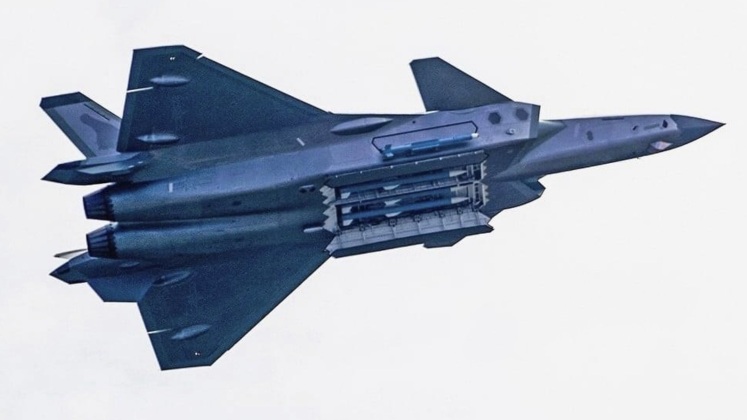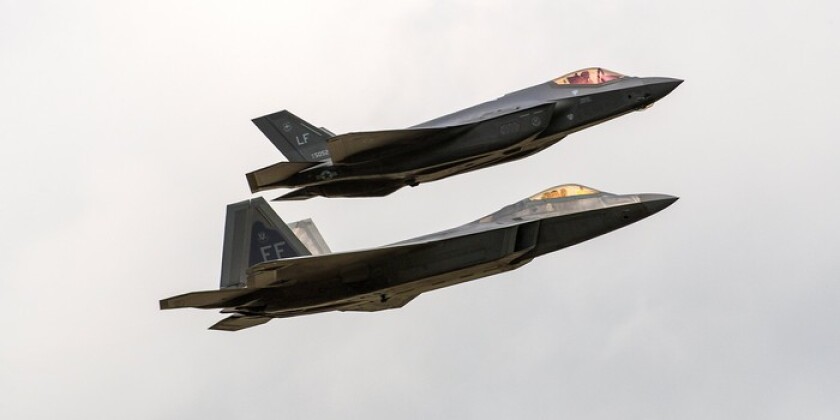News
2003 Study Sheds New Light on Mysterious Origins of China’s Top Fighter: Stealthy J-20 Has Surpassed Expectations

The Chengdu J-20 fifth generation fighter was the first non-American aircraft of its generation in the world to enter service, joining the Chinese People’s Liberation Army (PLA) Air Force in March 2017 after making it first flight jut six years prior. Although the aircraft symbolised China’s emergence as a leading power in military aviation reflecting the size of its economy and its investments in research and development, the nature of the program’s origins and its primary goals have remained more obscure than those of any other stealth fighter development effort. One rare source of valuable insight into China’s first fifth generation fighter program comes from a secretive Chinese language paper dating back to 2003 titled “Strategic Study of China’s Fighter Aircraft Development,” which described the rationale for developing a heavyweight next generation jet which would become the J-20 and the roles for which it would be intended. The paper appears to have been originally written between 1996 and 2003, and was authored by aerospace scholar Gu Songfen at the Chinese Academy of Sciences and Chinese Academy of Engineering, who had previously served in multiple high levels positions in the Chinese aerospace industry including as vice president and as chief designer at the Shenyang Aircraft Design Institute. Its content reflects the primary perceived threats of the era – namely fifth generation programs of the United States – as well as the priorities in Chinese fighter aviation, the expectations for the new fighter’s performance and the roles which the J-20 was intended to fulfil.
Although written before any fifth generation fighters had entered service, with the first the F-22 Raptor joining the U.S. Air Force only in late December 2005, development of such aircraft had been well underway since the late 1970s with both the Soviet Union and the United States having expected to begin fielding them around the year 2000. The F-22 program faced considerable delays as the U.S. defence sector sharply contracted in the 1990s, while the ambitious. MiG 1.42 was cancelled as the USSR disintegrated and Russia’s defence sector, research and development and general economy had by 1997 contracted to a fraction of their former sizes. The Chinese study emphasised the advantages that fifth generation fighters enjoyed over their fourth generation predecessors with superior communications, stealth capabilities, firepower and information centric warfare performances, and also stressed the increasingly central role air power was playing modern warfare which had seriously influenced Chinese military thought since the 1991 Gulf War. China’s military aviation sector had been approximately three decades behind the United States and Soviet Union when the Cold War ended, with close to three quarters of its fleet as a result relying on derivatives of the long since obsolete MiG-19 fighter from the mid 1950s, and it was only in 1991 that it had begun to receive fourth generation fighter from the Soviet Union in the form of the USSR’s top fighter the Su-27 Flanker. Widely considered the most capable heavyweight fighter of its generation, the Flanker would be fielded in larger numbers by China than any other country creating a trend in PLA service towards using such large fighters, which would pave the way towards development of the J-20 as a direct successor.

Developing a fifth generation fighter was described as means to facilitate significant improvements to both the PLA Air Force’s defensive and its offensive capabilities, and to provide an effective means of further advancing the country’s already very fast modernising military aviation industry. As indeed happened, the development of such a fighter was expected to stimulate development of advanced technologies that could further improve existing fourth generation designs. Notable examples are composite materials, AESA radars, data links and PL-15 and PL-10 next generation air to air missiles which, while developed for the J-20, were integrated onto the J-10C, J-11BG and J-16 fighters the latter two which are considered ‘4+ generation’ derivatives of the Su-27 Flanker. Similar trends were seen in the United States and Russia to lesser extents, with the latter using promising technologies from the unfinished MiG 1.42 to modernise fourth generation aircraft. A notable example was the Su-35 fighter’s AL-41F-1S engine, based on the Su-27’s AL-31F, which saw a 17 percent increase to thrust using technologies developed for the MiG 1.44’s own powerplant.

It was clearly stated in the report that the program which would produce the J-20 was focused on producing a fighter for air superiority with an emphasis on long range engagements, similarly to the American F-22 but differing from the MiG 1.42 which was intended to be more balanced and versatile. The fighter was to be capable of neutralising enemy support aircraft such as airborne early warning jets, of operating in informatized combat missions and providing targeting data to friendly assets, of conducting electronic attacks, and to act as an auxiliary airborne early warning aircraft using its own powerful sensor suite. Competing with the American F-22, and comfortably outperforming its lightweight single engine counterpart which later became the F-35, were important to the program, with the paper notably predicting that the F-35 could be fielded by the Taiwan-based Republic of China Air Force from the mid 2010s. This was consistent with China’s heavy investment in Flanker aircraft, which were designed to outperform America’s top heavyweight fighter the F-15, the F-22’s predecessor, and proved capable of doing so in multiple exercises.

In the 1990s and 2000s the F-22 saw 75 percent of its planned production run cut, with orders for termination given less than four years after its entry into service. Longstanding speculation that the troubled aircraft would see an early retirement was confirmed in 2021, and with the fighters having never been exported and slow to receive upgrades they have been left far behind the F-35 and J-20 in many key performance aspects. Notable examples include a lack of helmet mounted sights and very limed network centric warfare and electronic warfare capabilities. This has left the J-20 as the only heavyweight of its generation both fielded at squadron level strength and in production, rivalled by the more numerous but much lighter F-35. While the F-35 was not designed for high intensity air to air engagements, and was conceptualised primarily as a strike aircraft, progress developing the J-20 has led the United States to accelerate efforts to develop a sixth generation air superiority fighter as a successor to the F-22. Both China and the United States are expected to begin fielding such fighters around 2030.

The Strategic Study notably predicted that China’s aviation industry would struggle to develop a fifth generation engine for the J-20, suggesting that advanced fourth generation designs would power initial batches as was indeed the case. It projected that the aircraft would start full fledged development around 2006-2007, begin flight testing around 2013, and enter service in 2020 with its fifth generation engine entering service in 2021. As it was the fighter entered service around four years ahead of these projections, although its superior engine which has since materialised as the WS-15 is set to be commissioned three to four years behind. With next generation engines having been expected to have a thrust of just 15 tons, however, the WS-15 is expected to be considerably more powerful than originally projected with a thrust of around 18 tons expected. A 40-50 year life cycle, a radar cross section of less than 0.3 square meters and a high endurance allowing the fighter to cover all of Japan with just one aerial refuelling round, were all predicted, all of which are thought to have been achieved. An AESA radar yielding a tracking range of 200 kilometres and the ability to track 20 targets was perhaps the most notable specification given considering how underwhelming it was, with even lightweight AESA radars on smaller fighters such as the J-10C and F-16 Block 70 thought to have tracking ranges that are much higher while that of the J-20 is thought to be around twice as high.

Ultimately the J-20 program, unlike the F-22 or MiG 1.42, appears to have been highly successful not only meeting but superseding targets set for its performance and service entry schedule. The fighter’s lack of competitors from its weight range being produced on any serious scale has left it in a unique position, while tremendous investments have translated into very significant improvements to performance since 2017. The aircraft saw its first encounter with a foreign fifth generation fighter in March 2022, meeting American F-35s over the East China Sea, and has seen U.S. Air Force leaders reflect highly favourably on its performance with little dispute that the fighter in its latest variants is by far the most capable outside the United States. As new features for and variants of the fighter continue to be developed, including a twin seat variant unveiled in October 2021, the aircraft is expected to better fulfil roles other than air superiority including airborne command and control and electronic warfare for which an officer in the second seat will be key. In contrast to the F-22, the J-20 is expected to see a production run of several hundred with numbers expected to exceed 300 by mid-2024, and output expected to exceed 100 aircraft per year in 2025. The fighter is currently estimated to be being acquired by the Chinese People’s Liberation Army Air Force at over twice the scale at which any other service in the world is acquiring any other fighter class.












